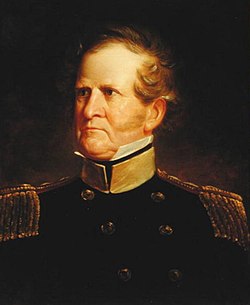Inception and construction
Two years after Maryland had ceded to the United States the territory constituting the present District of Columbia, the legislature of that state, appreciating the necessity of providing for the spiritual needs of the Protestant Episcopal inhabitants who were to reside there, and on their petition, passed the act of 26 December 1794, creating a new parish, to be known as Washington Parish-to be composed of so much of the Rock Creek Parish, in Montgomery County, Maryland, as St. John's Parish, in Prince George's County, Maryland, as was within the boundaries of the new city of Washington. In the next year a vestry was elected by the Episcopalians of the eastern end of the new parish, and the Rev. Mr. Ralph was appointed rector of the charge then organized, and took his seat in the Maryland Convention of 1795. This congregation occupied a small building on D Street and New Jersey Avenue, in the southeastern part of Washington, which since 1780, had been used as a chapel of ease connected with St. John Parish in Prince George's County. In 1806 a vestry was elected from the people worshipping at this chapel, and, in 1807, a new church was established in that vicinity, which was named Christ Church.
In Georgetown, in 1796, the Protestant Episcopal inhabitants had inaugurated a movement resulting in the establishment of a church within the new parish, which was consecrated in 1809-so that, when the general government was removed from Philadelphia, in 1800, the newcomers found three places of worship for Episcopalians within the district, two previously mentioned and the third being St. Paul's Church in Rock Creek Parish; but all too far removed from the central and more populated portion of Washington to be practically useful in those days of almost impassable roads. To supply this great need the residents in what was known as the First and Second Wards of Washington-lying between Georgetown and Sixth Street-in the year 1814 took decided measures to procure the erection of a church in the part of the city referred to. The persons who seem to have been most actively engaged in this work were Thomas H Gillis, James Davidson, Lund Washington, Peter Hagner, John Graham, John Peter Van Ness, Joshua Dawson, William Winston Seaton, John Tayloe III, Thomas Munroe, James Thompson, James H. Blake, David Easton, and Joseph Gales Jr.
The first entry in the earliest record book of the church, under date May 10, 1816, is in these words:
"May 10, 1816. At a meeting of citizens, resident in the First and Second Wards of the City of Washington, it was resolved that the following named gentlemen be appointed Trustees to manage the secular affairs of St. Johns Church, until a Vestry can be legally appointed, and to apply to the next Convention of the Protestant Episcopal Church for a division of the Parish of Washington; so as to attach the Parish of St. John's Church, viz: John Davidson, Peter Hagner, James Thompson, John Peter Van Ness, John Tayloe III, Thomas H Gillis, James H. Blake, and Roger C. Weightman."
On December 27, 1816, St. John's Day, Bishop James Kemp of Maryland performed the ceremonies of consecration, and religious services were conducted by the bishop and attendant clergy. The church building was designed by Benjamin Latrobe Esq, and constructed under his superintendence. He declined to receive any compensation for his valuable services, but the vestry voted him a pew free of rent, in acknowledgement of his generosity. This he declined, expressing his preference for some token that he might transmit to his children, and the testimonial took the form of a piece of plate. [5] John Tayloe III donated to the parish a communion service of silver, which Bishop William Meade, in his work on the old Churches of Virginia, says had been purchased by Col. Tayloe at a sale of the effects of the Lunenburg Parish Church/Farnham Church in Richmond County, Virginia, to prevent its desecration for secular use. [6]
Expansion
By 1842, it had become evident that further increases of the seating capacity of the church were expedient, and at a meeting of the pewholders called by public notice, on November 11, 1842, a committee, consisting of Richard Smith, John Canfield Spencer, Peter Hagner, Benjamin Ogle Tayloe, and William Thomas Carroll, was appointed to report a plan by which the number of pews should be increased, improved access given to galleries, and the interests of the existing pewholders properly adjusted. The committee reported on November 28, and in the following April, Col. John James Abert, Gen. Winfield Scott, Frank Markoe, and Charles Gordon, were appointed a committee to carry the plan into effect. In its execution the original arrangement of pews and aisles, which had hitherto remained substantially unchanged, was very greatly altered. The box and high-back pews were changed to low-back seats, the brick pavement disappeared with the old form of the aisles, the chancel was enlarged, and the wine-glass pulpit was removed.
Still more extensive changes were made in 1883 under the direction of Bancroft Davis and Gen. Peter V. Hagner, when almost all the windows were filled with stained glass, dedicated, for the most part, to deceased members of the congregation. The chancel was considerably enlarged, a new organ placed within the chancel rail, an addition made at the southeast corner of the church for a chantry, and a new vestry room, choir rooms, and offices erected. Altogether at least 180 sittings were added, making the entire sitting accommodation of the church at 780. [5]
In 1902, the formal state funeral of British ambassador Lord Pauncefote took place in St. John's Church.
























